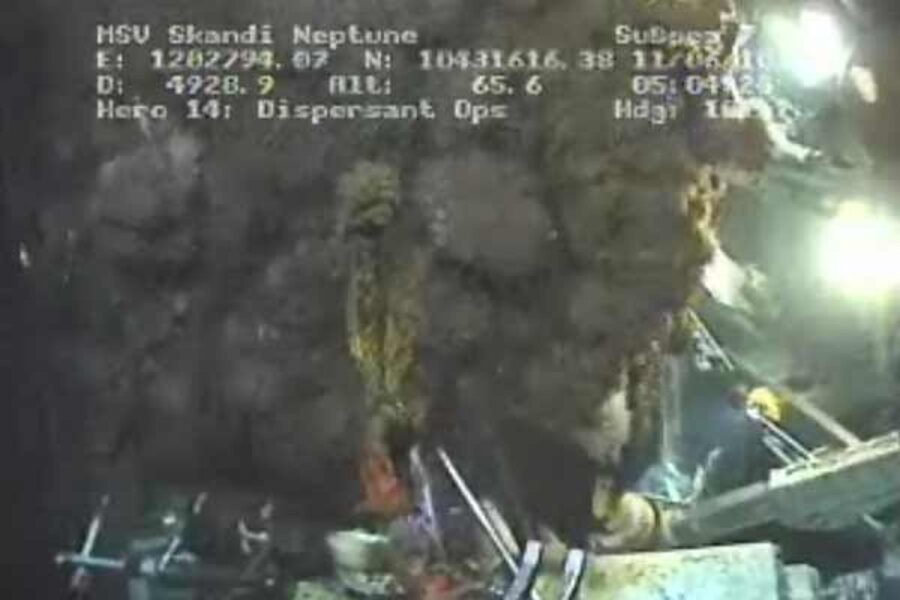New BP oil spill flow estimates: 20,000 to 40,000 barrels per day
Loading...
For nearly a month and a half, BP's Deepwater Horizon oil blow-out is likely to have pumped between 20,000 and 40,000 barrels of oil a day into the Gulf of Mexico, according to new estimates of the flow.
That eclipses initial estimates BP and the government used of 5,000 barrels a day -- estimates that scientists outside the government and the international oil giant quickly questioned.
The updated numbers give people coordinating clean-up efforts – as well as government investigators looking at potential civil and criminal charges against BP – a better idea of the full magnitude of the blow-out.
IN PICTURES: Sticky mess: The Gulf oil spill's impact on nature
On May 27, scientists working with the national incident command's flow-rate technical group released a preliminary estimate of 12,000 to 19,000 barrels a day. But they emphasized that this represented the minimum amount of oil leaking into the Gulf.
The latest revision suggests that until June 3, when BP began its effort to install a containment cap on the leaking well to capture as much of the oil as possible and deliver it to surface ships, the blow-out pumped as much as 1.76 million barrels of oil into the Gulf.
That's nearly two-thirds the amount of oil entering the Gulf as the region's worst platform spill, the Ixtoc blow-out in the Gulf of Campeche in 1979. That event sent some 3 million barrels of oil into the Gulf.
The flow-rate technical group, which now involves four teams of federal and academic scientists, draws on several approaches for estimating the flow and "is still a work in progress," says Marcia McNutt, who heads the US Geological Survey and the overall group of researchers building the estimates.
Over the next several days, she adds, the teams will work to narrow the gap between the high and low ends of the estimates. In addition, another group within the US Department of Energy is developing an independent estimate of the amount of oil being captured and the amount still leaking into the Gulf since BP installed the containment cap.
Each approach the teams are using has its own unique quirks, leading to different, though overlapping estimates.
One team, for instance, is analyzing high-definition video of the leak – video BP finally provided after the national incident command overseeing the response to the event demanded it – that puts the average daily leak rate at between 25,000 and 30,000 barrels, with uncertainties that suggest the leak could be as low as 20,000 or as high as 40,000 barrels a day.
Another team, analyzing only the oil at the surface, put their best estimate at between 12,600 and 21,500 barrels a day.
A third team outside the technical group, from the Woods Hole Oceanographic Institution, the University of Georgia, and the Massachusetts Institute of Technology, has provided the group with data from a remotely operated vehicle near the riser pipe. The ROV is equipped with acoustic sensors to measure the flow rate.
That team gave a low-end estimate of 25,000 barrels a day. While they haven't yet worked out a maximum figure, Dr. McNutt noted that by making a few assumptions, the upper bound could be as high as 50,000 barrels a day.
The quirks, or "biases," in each of the approaches are well known, McNutt acknowledges. Once all of the oil from the well is captured and its flow measured directly, researchers will be able to adjust their approaches to analyze their data in way that will allow them "to understand from Day 1 what the flow from a leaking well would be. That's our goal, to understand these biases and do it better next time," McNutt says.
Related:
- BP live feed doesn't lie: Is BP oil spill plume worse than before?
- Did BP intentionally 'low-ball' the extent of the Gulf oil spill?
- Gulf oil spill: Why BP's cap success is turning sour
IN PICTURES: Sticky mess: The Gulf oil spill's impact on nature





